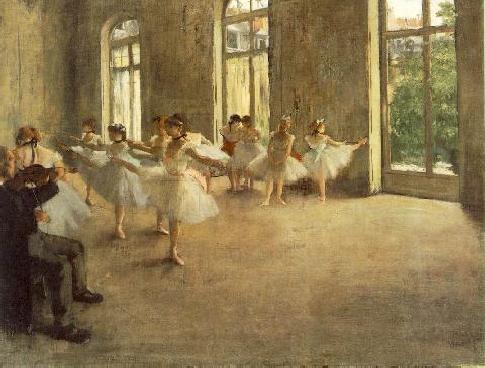The French born Edward Degas is perhaps better known for his subject matter than his individual paintings. Born in Paris, France on July 19, 1834, Degas is now remembered for his “Degas dancers,” as over half his work depicts dance or movement in some form. The eldest of five children, Degas was an expert draughtsman who wanted to become a classical historical painter.
As the son of a banker, he grew up in a somewhat wealthy family and was educated from an early age, studying literature and even enrolling in law school. His mother died when he was thirteen, leaving him to be raised mostly by his father and grandfather. Painting from an early age, in 1853 he registered as copyist in the Louvre. In 1855 Degas was admitted to the Ecole des Beaux-Arts, a notable art school in France, where he studied drawing with Louis Lamothe and studied the works of classical painters, such as Clouet and Poussin. He later traveled to Italy, staying with his aunt’s family in Naples, and spent several years studying and copying the art of the Renaissance and Middle Ages. It is claimed that, by 1860, he made over 700 copies of Italian and French classical pieces.
Returning to France in 1859, Degas setup a studio in Paris and started painting. His first piece of work to be accepted into a juried show was “Scene of War in the Middle Ages” in 1865 but it was not well-received. After visiting a friend in Normandy in 1861, Degas began painting horses for a time and then happened upon a chance meeting with Edouard Manet in the Louvre.
Degas enlisted in the national guard to serve in the Franco-Prussian war in 1870 but was found to have poor eyesight. After the war ended in 1872, Degas moved to New Orleans, Louisiana, where his brother lived with several other relatives, and started painting again. In 1873, Degas found himself back in Paris and the following year Degas’ father died, leaving him to discover his family had incurred a great deal of business debt. It was this year, 1874, that Degas joined forces with a group of artists who would become known as The Impressionists, though he sometimes resented their use of color and landscape paintings, even mocking them for their plein air style of painting.
In the late 1880’s Degas also took up photography and would take many reference photographs for his drawings and paintings. Not restricted to one medium though, Degas was working in pastel as late as the end of 1907 and sculpture until 1910. He stopped working in 1912 when he was forced to move from him home and spent the last years of his life nearly blind restlessly wandering the streets of Paris until his death in 1917.
Degas is often lumped in with the Impressionist painters, and he did frequently exhibit with them, but his work was somewhat different from the pack. He never quite adopted their use of color fleck, never painting the effects of light on bright colors, instead he worked with a more determined color palette. He also mocked their practice of painting en plein air, or creating outdoor landscapes. Degas had a less idyllic view of the figure than the Impressionists, often painting portraits of individuals and groups but using awkward crops and unusual angles and perspectives, with light coming from below to create a theatrically focused space. He was especially drawn to tensions between men and women and often painted women in working situations, such as milliners and laundresses.
From 1870 Degas painted ballet dancers, often showing their backstage rehearsals or otherwise showing off their status as professionals doing a job. His ballet dancers are very “behind the scenes” and almost have a cinematic flair to them, since he had a preference for painting “real life” instead of more traditional styles. As his subject matter changed, Degas shifted his color palette as well, moving from a more dark Dutch influenced palette to a more vivid use of color, with oils applied in translucent cross-hatching and pastels applied in many successive layers, each layer except the last fixed.
What Photographers Can Learn From Him
Degas paintings can almost be read as snapshots or moments frozen in time, giving them an innate sense of movement. The notion that a still composition can depict a sense of movement is very evident in Degas’ work. The softer use of color can be linked to his interest in photography, which was then a new technique. He favored spontaneous compositions and off-kilter angles with light coming from below to create a dramatic effect. A photographer could easily adopt a similar lighting technique to create such a theatrically focused space on a still frame rather than a painter’s canvas.
The very subject of the ballerina or the dancers and the concept of capturing movement are very powerful takes for a photographer. Still images represent a single frame, a small slice of an event, happening, or movement, a gesture rather than a full movement, but that doesn’t mean movement is not there. Our subjects are always in motion even if our compositions are not, and the idea that Degas painted revelations in movement is a compelling take for a photographer. His compelling use of movement coupled with his sense of reality and emotional impact is what made his work so captivating and photographers could learn a lot from that.
Degas preferred line and contour, shape over color, urban over pastoral, studio work over plein air painting. The idea that a work can convey movement, can have an innate sense of movement, coupled with an openness that comes from an off-center composition and dramatic lighting can be brought immediately into the world of photography.
Many photographers work openly with motion, but many others avoid it, opting instead for a sharper, more crisp line. Degas did not neglect line in favor of motion, rather he gave us both. The very notion of combining the deliberate inclusion of movement into a composition with open space and forging shapes and line rather than abstraction can be included in modern photography. Photographers can use this idea by opting to work with motion, paying attention to line and form in the composition, and working efficiently with space. To see examples of a photographer I feel is working along these lines and in this context, look at the dancers and even some of the portraits by modern photographer Joe McNally.
Thanks to his innate sense of movement and motion, his attention to line and contour, and his unusual off-center compositions, Edward Degas earns his spot in the ranks of Painters Every Photographer Should Know. You can read more about Edward Degas on the Wikipedia link about him, and look for more painters (and posts) in the series to come.
—————————————————————————————————————
This is next in a series called “Painters Every Photographer Should Know.” The painting shown here is The Rehearsal c. 1873-78; Oil on canvas, 41 x 61.7 cm (18 1/2 x 24 3/8 in). Please note that the paintings and photographs in this series are not copyright the author of this website, may be subject to international copyright law, and are provided her for educational purposes only.


Author
What is interesting to me is how, today, we can look at dance as film, and how any moment can be frozen with a 'pause button'. This is what I like about Edouard Locke and the Canadian dance company, "Lala, Human Steps"…he is one of the first to think that dance can not be just the dance. It can be a film. Dance as film, was an art form with him, like Degas freezing motion, taken to the next step. Check him out on Youtube!
Author
I will. Thanks for the suggestion.
Author
Edward or Edgar